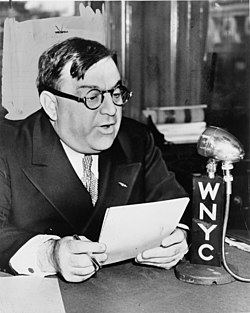Fiorello La Guardia
Fiorello Henry La Guardia (sometimes LaGuardia) (pronounced /fiəˈrɛloʊ ləˈɡwɑrdiə/; born Fiorello Enrico La Guardia) was Mayor of New York City for three terms from 1934 to 1945. A member of the Republican Party,[1][2][3][4][5][6][7][8] La Guardia is acclaimed as one of the greatest mayors in American history.
Fiorello La Guardia | |
|---|---|
 Mayor La Guardia speaks over WNYC on Grade A milk from Budget Room, 1940. | |
| 99th Mayor of New York City | |
| In office 1 January 1934 – 31 December 1945 | |
| Preceded by | John P. O'Brien |
| Succeeded by | William O'Dwyer |
| Member of the U.S. House of Representatives from New York's 20th district | |
| In office March 4, 1923 – March 3, 1933 | |
| Preceded by | Isaac Siegel |
| Succeeded by | James J. Lanzetta |
| 10th President of the New York City Board of Aldermen | |
| In office January 1, 1920 – December 31, 1921 | |
| Preceded by | Robert L. Moran |
| Succeeded by | Murray Hulbert |
| Member of the U.S. House of Representatives from New York's 14th district | |
| In office March 4, 1917 – December 31, 1919 | |
| Preceded by | Michael F. Farley |
| Succeeded by | Nathan D. Perlman |
| Personal details | |
| Born | 11 December 1882 Greenwich Village, Manhattan |
| Died | 20 September 1947 (aged 64) Bronx, New York City |
| Political party | Republican |
Career
He was elected to Congress in 1916 and 1918, and again from 1922 through 1930. La Guardia is often touted as one of the greatest mayors in American history. Since he was only five feet tall and his first name was Italian for "Little Flower", he was called "the Little Flower" throughout his life.[9] He moved to Arizona with his family, where his father had a bandmaster position at Fort Whipple in the U.S. Army.
La Guardia, a Republican who was liked across party lines, was very popular in New York during the Great Depression. As a supporter of the New Deal, he supported President Franklin D. Roosevelt, a Democrat, and in turn Roosevelt heavily funded the city and cut off patronage from many politicians and establishments who did not support La Guardia. Many people felt that La Guardia improved New York City economically and socially and restored public faith in City Hall.
During his terms, he unified the transit system, directed the building of low-cost public housing, public playgrounds, and parks, constructed airports, reorganized the police force, defeated the powerful political machine Tammany Hall, and improved employment rates in New York City, even during the depression.
In the mid-1940s, there was a newspaper strike in New York City. La Guardia responded to the public clamor by sitting at a radio microphone and describing and reading the Sunday comics to the children of the city. He described the cartoons and portrayed the dialects and accents of the characters. This endeared La Guardia to the electorate and the children of New York and gave him a larger national image.
Personal life
La Guardia’s father was a Roman Catholic-turned-atheist, and his mother was Jewish, albeit a non practising one.[10] La Guardia himself was Episcopalian.[11]
Fiorello La Guardia Media
La Guardia at his Interpreter's desk on Ellis Island c. 1910
Portrait by Underwood & Underwood, 1918
Congressmen Fiorello La Guardia and William Sirovich sample a foul-smelling industrial alcohol additive to replace poisonous deterrents, 1930
La Guardia and Franklin D. Roosevelt, 1938
American Labor Party campaign poster featuring La Guardia and Jewish labor leader Baruch Charney Vladeck, 1937
Senator George W. Norris of Nebraska (left) and mayor La Guardia in 1938
La Guardia and his family during their time at Fort Whipple, Arizona, in the 1890s
References
- ↑ Elliott, Lawrence 1983. Little Flower: The Life and Times of Fiorello La Guardia. New York: William Morrow. ISBN 0-688-02057-7.
- ↑ Garrett, Charles 1961. The La Guardia Years: Machine and Reform Politics in New York City. New Brunswick, NJ: Rutgers University Press.
- ↑ Goldstein, Richard 2010. Helluva Town: The Story of New York City During World War II. Online review
- ↑ Hecksher II, August 1978. When La Guardia Was Mayor: New York's Legendary Years. New York: W.W. Norton. ISBN 0-393-07534-6.
- ↑ Jeffers H. Paul 2002 The Napoleon of New York: Mayor Fiorello La Guardia. New York: John Wiley. ISBN 0-471-02465-1. The%20Napoleon%20of%20New%20York%3a%20Mayor%20Fiorello%20La%20Guardia online edition[dead link].
- ↑ Kaufman, Herbert "Fiorello H. La Guardia, Political Maverick". Political Science Quarterly 1990 105(1): 113–122. ISSN 0032-3195 in Jstor
- ↑ Kessner, Thomas. 1993. "Fiorello H. LaGuardia." History Teacher. 26(2): 151–159. ISSN 0018-2745 in Jstor
- ↑ Kessner, Thomas 1989. Fiorello H. LaGuardia and the Making of Modern New York. New York: McGraw-Hill ISBN 0-07-034244-X
- ↑ Gunther, John (1947). "The Not-So-Little Flower". Inside U.S.A. New York, London: Harper & Brothers. pp. 578–588.
- ↑ Brodsky, Alyn (2003-06-29). "'The Great Mayor'" (in en-US). The New York Times. . https://www.nytimes.com/2003/06/29/books/chapters/the-great-mayor.html. Retrieved 2023-02-17.
- ↑ "Le radici triestine di Fiorello LaGuardialeggendario sindaco di New York City". Il Piccolo (in italiano). 2007-05-31. Retrieved 2023-02-17.
- ↑ "Home". acgl.online. Archived from the original on 2023-01-03. Retrieved 2023-02-17.








